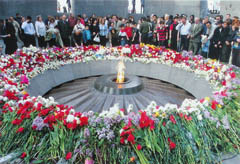31.03.2009

2009 marks the 90th anniversary of April 24 as a day of commemoration. Here is the history of this important event:
A special committee was formed in Constantinople, in March 1919, by a group of Ottoman Armenian intellectuals who survived the Armenian Genocide. The main goal of this committee was the organization of commemoration ceremonies dedicated to the 4th anniversary of the Armenian Genocide. The committee, known as “The April 11th Board of Ceremonial Mourning” consisted of 13 members including Yevphime Avetisian, Zaruhi Galamkarian, Mari Stambulian, Perchuhi Parsamian, Miss Arpiar, Tigran Zaven, Merujan Parsamyan, Hakob Siruni, Gevorg Mesrop, Tagvor Suqiasian, Dr. Barsegh Tinanian, Shahan Perperian and Hovhannes Poghosian. Due to the efforts of these people the memory of the victims of Armenian Genocide was commemorated among the Armenians of Constantinople for the first time in 1919. Armenian writer, publicist and public figure Hakob Siruni wrote in his memoirs: “The mourning ceremony became a tradition. Since then, the 24th of April was adopted as a symbol of mourning.”
According to the committee, commemoration ceremonies were intended to be held from April 11th through the 18th, but due to the Armenian Patriarch’s illness at the time, the date was delayed by one day. Bishop Mesrop Naroian held a liturgy for the victims of the Armenian Genocide from April 15th to the 25th in St. Trinity church of Bera district of Constantinople. The Armenian patriarch of Constantinople, Zaven Eghiaian, gave a sermon. On this proclaimed “day of mourning,” all Armenian national colleges and shops in Constantinople were closed. Representatives of Saint Trinity Greek Church, RA P. Takhtadgian and others presented public statements during the ceremony.
During the afternoon, those attending the ceremony gathered Armenians moved on to the St. Trinity Armenian Evangelical Church located in the Cheshme district of the city. After the liturgy, the ceremonial mourning took place, marked with speeches, declamations and sacred music. Shahan Perperian gave the opening remarks on behalf of the Board of Ceremonial Mourning followed by representatives of the Armenian parties, including Vahan Zeituntsian and Professor H. Hakobian, Dr. Khandjian from the Doctor’s Union, Gevorg Mesrop from the Teacher’s Union along with many others. The speeches were intermingled with declamations and sacred music. A volume entitled “Memorial for April 11th ” was published in Constantinople (published by - O. Arzumanian, 1919) edited by Theodik. It was published specifically for the Day of Mourning. This volume included the biographies, photos and unprinted pages of the Armenian martyrs of Constantinople and other provinces.
This initial commemoration for the victims of the Armenian Genocide in Constantinople was not the only one of its kind. On April 24, 1919, again in the St. Trinity Church in Bera, another liturgy was held for the same cause. It was officiated by the Armenian Patriarch, this time commemorating the American missionaries martyred during World War I. Representatives of the US Embassy to Turkey: Mr. Heike and Mr. Faull, a journalist from the “Times”, colonel Bennett and others brought their participation during the ceremony.
The next day, on April 25th, a similar ceremony dedicated to the martyrs of the Armenian Genocide took place in the Armenian Catholic Church at the Vatican under the approval of Pope. The entire Armenian community in Italy was present along with several Cardinals and Bishops (as representatives of the Pope), members of the Italian Government, Minister of Education M.Ludzatti, Speaker of Parliament Lombardo, Deputy Foreign Minster, French ambassador to Italy and other officials.
Since the first commemoration of the Armenian Genocide victims in Istanbul, April 24 officially was adopted as “Day of Mourning and Commemoration”.





